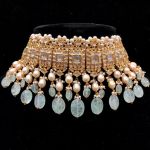
Navaratna (Sanskrit: नवरत्न) is a Sanskrit compound word meaning “nine gems”. Jewellery created in this style has important cultural significance in Hinduism, Jainism, Buddhism, and Sikhism, among other religions.
Gems and planets
“Top quality and flawless ruby is the gem for the Sun, natural pearl for the Moon, red coral for Mars, emerald for Mercury yellow sapphire for Jupiter, diamond for Venus, blue sapphire for Saturn, hessonite for Rahu (ascending lunar node), and cat’s eye for Ketu (descending lunar node).”
Setting arrangement
Nine navaratna gems in a Nava-graha pendant-yantra.
The traditional setting and arrangement of these nine gems is shown in the illustration. A ruby (representing the Sun) is always in the center, surrounded (clockwise from the top) by a diamond, a natural pearl, red coral, hessonite, a blue sapphire, cat’s eye, a yellow sapphire, and an emerald. This is the same placement as the Nava-graha Yantra.
Traditionally, no gem other than a ruby or a red spinel is set in the center of a nine gems arrangement. To do so is believed to go against the flow of nature. Because the Sun is the center of the solar system, its gem is positioned in the heart of a Navaratna Talisman.



That is very interesting, You’re a very skilled blogger. I’ve joined your rss feed and look ahead to in quest of more of your wonderful post. Additionally, I’ve shared your site in my social networks!